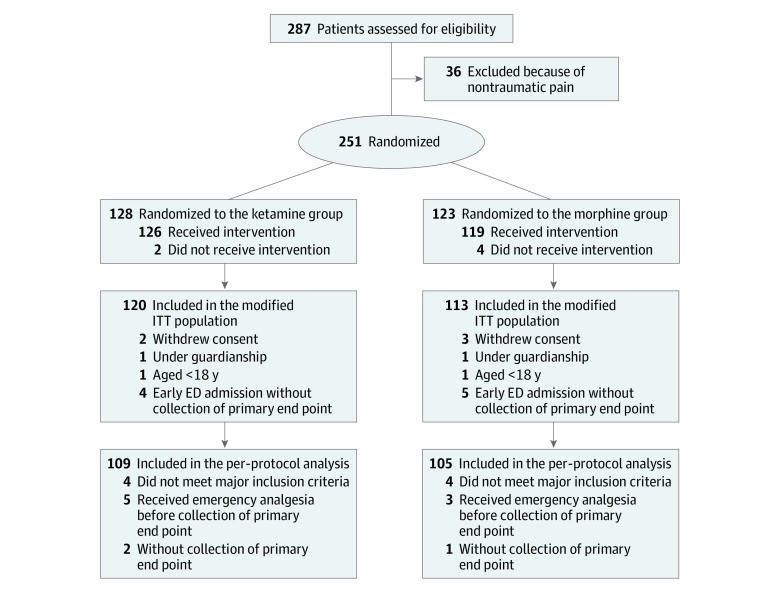Ketamine and morphine are both potent analgesics, but they work through different mechanisms. This article explores a study comparing the strength and effectiveness of ketamine and morphine for out-of-hospital traumatic pain relief.
 Mean pain score changes at 30 minutes
Mean pain score changes at 30 minutes
Ketamine vs. Morphine: A Head-to-Head Comparison for Pain
A multicenter, randomized clinical trial known as the KETAMORPH study directly compared intravenous ketamine to intravenous morphine in patients experiencing out-of-hospital traumatic pain. The study aimed to determine if ketamine was noninferior to morphine in providing pain relief.
Study Design and Findings
The KETAMORPH study involved 251 adult patients with traumatic injuries and significant pain levels. Participants were randomly assigned to receive either ketamine or morphine intravenously. Pain levels were assessed using a verbal rating scale before and at various time points after drug administration. The primary outcome was the change in pain score 30 minutes after treatment.
Results showed that the mean pain score reduction at 30 minutes was remarkably similar in both groups: -3.7 for ketamine and -3.8 for morphine. This minimal difference of 0.1 points met the pre-defined criteria for noninferiority, meaning ketamine performed as well as morphine for pain control.
Figure 2: Difference in pain between the ketamine and morphine groups over time.
Ketamine: A Viable Alternative to Morphine for Pain Management?
The KETAMORPH study provides strong evidence that ketamine offers comparable pain relief to morphine in acute traumatic pain situations. This is significant, especially considering the ongoing opioid crisis and the risks associated with morphine use, such as respiratory depression, addiction, and oversedation. Ketamine, acting through a different mechanism, may provide a valuable opioid-sparing alternative for managing acute pain in prehospital settings.
While the study found ketamine to be as effective as morphine for pain relief, it also noted a higher incidence of adverse effects, primarily emergence phenomena like hallucinations and agitation, in the ketamine group. However, these side effects were generally mild and did not require specific interventions.
Implications for Pain Treatment Protocols
The findings of this study have potential implications for pain management guidelines and protocols, particularly in prehospital emergency care. Ketamine’s efficacy, coupled with its opioid-sparing potential, positions it as a strong contender for inclusion in pain management strategies for acute traumatic pain. However, careful consideration of potential adverse effects and appropriate patient selection are essential.
Addressing the Opioid Crisis with Ketamine for Pain
The opioid epidemic necessitates exploring and validating alternative pain management options. The KETAMORPH study highlights ketamine’s potential role in reducing reliance on opioids for acute pain. Further research is needed to investigate long-term outcomes, optimal dosing strategies, and the best approaches to managing ketamine’s side effects. This research reinforces the need for a multifaceted approach to the opioid crisis, including expanding access to effective non-opioid pain relievers like ketamine.
Limitations and Future Research Directions
The study had some limitations, including its single-blind design and the relatively short follow-up period. Further research should focus on:
- Long-term effects: Evaluating the long-term pain relief and safety of ketamine compared to morphine.
- Different pain conditions: Assessing ketamine’s effectiveness in other types of acute and chronic pain.
- Optimal dosing: Refining ketamine dosing protocols to minimize side effects while maximizing pain relief.
- Specific patient populations: Determining the efficacy and safety of ketamine in specific patient groups, such as those with pre-existing medical conditions.
Conclusion
The KETAMORPH study offers compelling evidence for ketamine’s efficacy as a non-opioid alternative to morphine for managing acute traumatic pain in out-of-hospital settings. While further research is needed, these findings support ketamine’s potential to play a crucial role in combating the opioid crisis and improving pain management practices.
